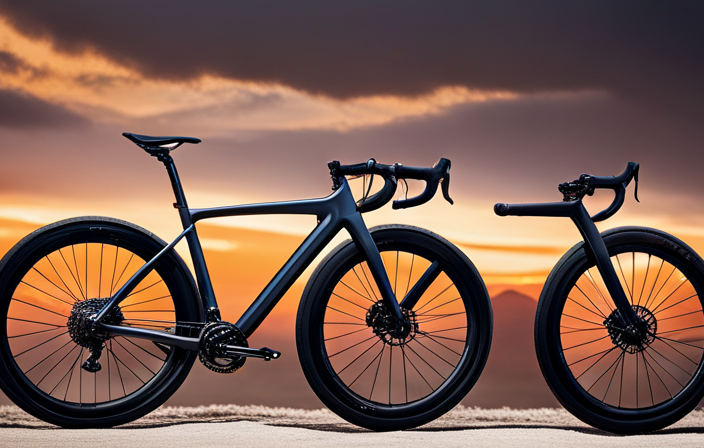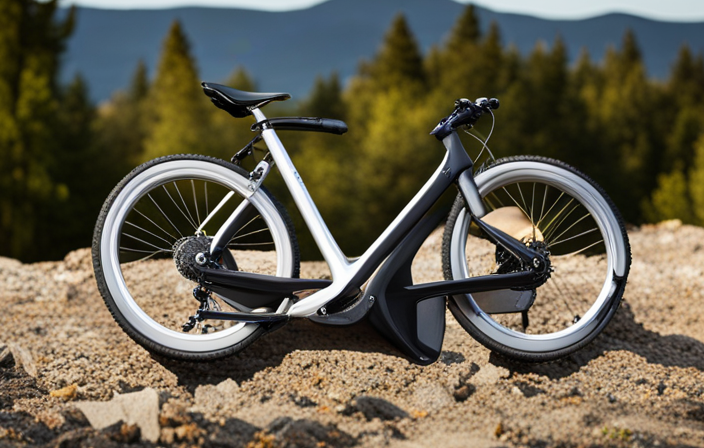Comparing the toughness of off-road paths with the speed and effectiveness of road biking, gravel grinder bikes have become an exciting hybrid in the cycling community. These adaptable machines are built to handle a range of surfaces, from sleek pavement to rough gravel trails. Featuring robust frames, wider tires, and endurance-oriented geometry, they provide an exciting experience for cyclists looking for adventure beyond conventional road biking.
In this article, I will delve into the origins, anatomy, events, and gear associated with gravel grinder bikes. Get ready to explore new horizons on two wheels!
Key Takeaways
- Gravel grinder bikes emerged in the early 2000s as a new cycling discipline, driven by a desire for adventure and exploration.
- These bikes gained popularity for combining endurance and technical skills, offering an escape from traffic-filled roads.
- The anatomy and design of a gravel grinder bike prioritize stability and comfort, with features such as ample tire clearance, disc brakes, and suspension systems.
- Gravel grinder bikes excel on various terrains, including gravel roads, fire trails, singletrack, and technical trails, making them versatile for different types of riding.
The Origins of Gravel Grinding
So, you might be wondering where exactly the whole gravel grinding craze started. Well, let me take you back to the origins of this exhilarating cycling discipline.
Gravel grinding gained popularity in the early 2000s as a result of cyclists seeking new challenges and adventures beyond the traditional road or mountain bike experiences. It was born out of a desire to explore unpaved roads, remote gravel paths, and rugged terrain that offers a unique blend of excitement and serenity.
Gravel grinding quickly captivated riders with its ability to combine endurance, technical skills, and a sense of exploration. As word spread about this thrilling form of cycling, more and more enthusiasts began seeking out their own gravel adventures. The allure of escaping traffic-filled roads while immersing oneself in nature became irresistible for many riders.
The popularity of gravel grinding has grown exponentially over the years as manufacturers started producing specialized bikes designed specifically for this demanding discipline. These bikes, known as gravel grinder bikes or simply ‘gravel bikes,’ feature characteristics borrowed from both road and mountain bikes. They typically have wider tires for improved traction on loose surfaces, disc brakes for enhanced stopping power in all conditions, and a more relaxed geometry for increased stability on rough terrains.
With an understanding of the origins and popularity behind gravel grinding established, it’s time to delve into the anatomy of a gravel grinder bike without further ado.
The Anatomy of a Gravel Grinder Bike
When it comes to gravel grinder bikes, there are three key factors that make them unique and capable of tackling rough terrains.
First, the frame design and geometry play a crucial role in providing stability and comfort during long rides.
Second, ample tire clearance and width allow for greater traction and the ability to handle various road conditions.
Lastly, the integration of disc brakes and suspension systems provides superior stopping power and reduces fatigue on bumpy trails.
These features combined make gravel grinder bikes an exciting choice for adventurous riders seeking versatility and performance on mixed surfaces.
Frame Design and Geometry
To understand the frame design and geometry of a gravel grinder bike, you’ll notice that it is specifically engineered for endurance and versatility. The frame materials used in these bikes are often a combination of lightweight carbon fiber and durable aluminum alloy, ensuring strength without sacrificing weight. Bike fit is another crucial aspect that manufacturers consider when designing gravel grinder frames. These frames are designed to provide a comfortable riding position for long hours on rough terrains, allowing riders to maintain optimal power transfer and control.
When it comes to frame geometry, gravel grinder bikes typically feature a longer wheelbase and slacker head tube angle compared to road bikes. This provides stability and confidence on uneven surfaces while still maintaining agility for maneuvering through tight corners. Additionally, the higher bottom bracket height helps prevent pedal strikes on rocky trails.
Moving on to the next section about tire clearance and width…
Tire Clearance and Width
The clearance and width of the tires on a gravel grinder bike are designed to handle various terrains. Gravel roads can vary in surface conditions, from loose gravel to hard-packed dirt, and even muddy sections. To navigate these different terrains effectively, tire pressure plays a crucial role.
Lower tire pressures provide better traction on loose surfaces, while higher pressures are ideal for smoother roads. The wider tires found on gravel grinder bikes offer increased stability and control, allowing riders to confidently tackle rough terrain. With wider tires, there is also more room for mud or debris to pass through without getting stuck between the tire and frame. This ensures consistent performance and avoids unnecessary friction or damage.
Transitioning into the next section about disc brakes and suspension systems, these components further enhance control and safety when riding in challenging conditions.
Disc Brakes and Suspension Systems
If you want to enhance your control and safety while riding in challenging conditions, consider investing in a gravel grinder bike equipped with disc brakes and suspension systems.
These features provide several advantages that are crucial for off-road performance.
Advantages of hydraulic disc brakes: Compared to traditional rim brakes, hydraulic disc brakes offer superior stopping power and modulation. They perform consistently well in wet or muddy conditions, giving you more confidence on descents or when navigating technical sections.
Suspension systems for off-road performance: Gravel grinder bikes with suspension systems absorb bumps and vibrations from rough terrain, allowing for a smoother ride and better traction. This feature is especially beneficial when riding on gravel roads or trails with uneven surfaces.
With the combination of disc brakes and suspension systems, you’ll have better control over your bike’s braking and handling, making it easier to navigate challenging terrains. This enhances your overall riding experience and increases your ability to tackle various types of terrain with ease.
Versatility on Various Terrains
When it comes to gravel grinder bikes, their versatility on various terrains is truly remarkable. Whether you’re tackling gravel roads and fire trails or exploring singletrack and technical trails, these bikes are up for the challenge.
And don’t think they’re limited to off-road adventures – they also excel on road rides and make for a comfortable commuting option. These bikes are designed to handle it all, allowing you to explore new terrain with confidence and experience the thrill of cycling in any setting.
Gravel Roads and Fire Trails
Gravel grinder bikes are designed for riding on gravel roads and fire trails. These bikes are built to handle the rough and unpredictable surfaces that you might encounter on these types of terrain. They have wider tires with a more aggressive tread pattern, providing better traction and stability.
Gravel grinder events have gained popularity in recent years, attracting cyclists who enjoy the challenge of long-distance rides on mixed surfaces. Additionally, gravel bikepacking has become a popular activity for adventure-seekers looking to explore remote areas and camp overnight.
Riding on gravel roads and fire trails allows you to experience the beauty of nature while pushing your limits on two wheels. But our journey doesn’t end there; let’s now delve into the exciting world of singletrack and technical trails.
Singletrack and Technical Trails
Singletrack and technical trails offer thrilling challenges for riders seeking an adrenaline-fueled adventure. The art of singletrack riding is all about navigating narrow, winding trails that twist and turn through dense forests or rugged terrain. It requires quick reflexes, precise bike handling skills, and the ability to make split-second decisions.
Technical trail challenges, on the other hand, push riders to their limits with rock gardens, drop-offs, tight switchbacks, and steep descents. Negotiating these obstacles demands a combination of strength, finesse, and mental focus.
As a gravel grinder bike enthusiast, I thrive on the excitement that comes from conquering these treacherous paths. Each ride is like a puzzle waiting to be solved as I analyze the trail ahead and choose my lines carefully. The satisfaction that comes from successfully maneuvering through challenging sections is unparalleled.
But now it’s time to transition into road riding and commuting, where gravel grinders truly excel in versatility and performance.
Road Riding and Commuting
To fully embrace the versatility and performance of your gravel grinder, you’ll find road riding and commuting to be an exciting new chapter in your cycling journey. Road riding allows you to experience the speed and efficiency of your bike on smooth surfaces, while commuting gives you the freedom to navigate through traffic with ease. It’s important to ensure that your gravel grinder is well-maintained for these activities. Regular bike maintenance, such as checking tire pressure, cleaning and lubricating the drivetrain, and inspecting brake pads, will help keep your bike in optimal condition for road riding and commuting. Remember to also dress appropriately for the weather and have essential accessories like lights and fenders. By taking care of your bike and being prepared, you can enjoy the thrill of road riding on your gravel grinder. Now let’s delve into choosing the right components for even greater performance.
Choosing the Right Components
When choosing the right components for your gravel grinder bike, it’s important to consider factors such as durability and versatility. The components you choose will greatly impact the performance and enjoyment of your rides on various terrains. Here are three key considerations to keep in mind:
-
Component compatibility: Make sure all the components on your bike work together seamlessly. This includes everything from the drivetrain and brakes to the wheels and tires. Having compatible components ensures smooth shifting, reliable braking, and overall better performance.
-
Weight and durability trade-offs: Gravel riding can be demanding, so finding a balance between lightweight components and durability is crucial. Lightweight parts can improve speed and maneuverability, but may sacrifice strength and longevity. On the other hand, durable components might add weight but can withstand rough conditions.
-
Versatility: Gravel riding encompasses a wide range of terrain, from smooth dirt roads to rugged trails. Choosing versatile components that can handle different surfaces will enhance your riding experience. Look for features like wider tire clearance, adjustable suspension forks, and multiple gear ratios to adapt to different conditions.
Considering these factors will help you select the right components that suit your riding style and preferences for an optimal gravel grinding experience.
As we delve into bikepacking and adventure cycling in the next section…
Bikepacking and Adventure Cycling
For an exciting and immersive outdoor experience, consider bikepacking and embarking on adventurous cycling journeys. Bikepacking is a form of long-distance cycling where riders carry all their gear on their bikes, allowing for more flexibility in route choices and the ability to explore remote areas.
To fully enjoy this type of cycling, having the right bikepacking gear is essential. A gravel grinder bike is a great choice for bikepacking due to its versatile nature and ability to handle various terrains.
When planning your bikepacking adventure, it’s crucial to research and choose the best gravel grinder routes that suit your preferences and skill level. Look for routes that offer scenic views, challenging terrain, and opportunities for camping or staying in accommodations along the way. Consider factors such as distance, elevation gain, road conditions, and availability of services.
Investing in quality bikepacking gear will ensure a comfortable journey. Essential items include a lightweight tent or bivvy bag, sleeping bag, cooking equipment, food supplies, water filtration system, repair tools, spare parts, and clothing suitable for various weather conditions.
As you plan your adventure and gather your gear, don’t forget about maintenance and care tips to keep your gravel grinder bike in top condition throughout your journey without compromising performance.
Maintenance and Care Tips
As we transition from discussing bikepacking and adventure cycling, it’s important to emphasize the significance of maintenance and care when it comes to gravel grinder bikes. These rugged machines are built to endure rough terrains and challenging conditions, but they still require regular attention to ensure optimal performance and longevity.
To help you keep your gravel grinder bike in top shape, here are some essential maintenance tips and care techniques:
| Maintenance Tips | Care Techniques |
|---|---|
| Regularly clean | Lubricate moving parts |
| Check tire pressure | Inspect for damage |
| Monitor chain wear | Protect from elements |
| Adjust brakes | Store properly |
Regular cleaning is crucial as it helps remove dirt, mud, and debris that can accumulate during rides. Lubricating moving parts such as the chain, derailleurs, and pedals will prevent friction and promote smooth operation. Monitoring tire pressure ensures optimal grip on different surfaces while also minimizing the risk of flats.
Inspecting for damage is vital to catch any issues early on before they worsen. Additionally, protecting your bike from elements like rain or extreme temperatures can prolong its lifespan. Lastly, proper storage will prevent unnecessary wear or damage when not in use.
By following these maintenance tips and care techniques, you’ll be able to keep your gravel grinder bike performing at its best for all your upcoming adventures on the road less traveled.
Now let’s shift gears into exploring the exciting world of gravel grinder bike events and races!
Gravel Grinder Bike Events and Races
Get ready to experience the thrill of participating in gravel grinder bike events and races! Gravel grinder bike events are a great way to test your skills and endurance on rough terrains. Here are three key things you need to know about these exciting events:
-
Gravel grinder bike equipment: To excel in gravel grinder events, it is crucial to have the right equipment. A gravel-specific bike with wider tires for better traction and stability is essential. Additionally, a sturdy frame and reliable brakes will help you tackle any obstacles along the way.
-
Training for gravel grinder events: These races require a combination of stamina, strength, and technical skills. Incorporating both road and off-road training into your regimen will prepare you for the diverse challenges that come with gravel grinding. Focus on building endurance through long rides and practice handling your bike on varying terrain.
-
Joining gravel grinder races: There are numerous gravel grinder races organized worldwide, ranging from local community rides to high-profile competitions. Participating in these events not only allows you to showcase your abilities but also provides an opportunity to connect with fellow enthusiasts.
Now that we’ve covered the excitement of participating in gravel grinder bike events, let’s move on to exploring the accessories and gear necessary for this thrilling adventure without missing a beat!
Accessories and Gear for Gravel Grinding
To fully enjoy your gravel grinding experience, it’s important to have the right accessories and gear. When it comes to accessories, there are a few essentials that every gravel grinder should have.
First and foremost, a good helmet is crucial for safety on any ride. Look for one with MIPS technology for added protection against rotational forces.
Additionally, a hydration pack or water bottle cage is essential to stay hydrated during long rides.
As for gear, a reliable bike computer can provide valuable data such as distance, speed, and elevation gain. It’s also worth investing in a comfortable pair of cycling shorts with padding to reduce friction and chafing during long hours in the saddle. Don’t forget about proper footwear too – sturdy shoes with grippy soles will help you navigate tricky terrain.
Training and nutrition play an important role in gravel grinding as well. To improve your performance, consider adding strength training exercises to your routine and focus on building endurance through longer rides. Proper nutrition is also key – fueling your body with balanced meals and snacks will help maintain energy levels throughout your rides.
With the right accessories and gear, along with proper training and nutrition, you’ll be well-prepared for your gravel grinding adventures.
Now let’s dive into the pros and cons of gravel grinder bikes…
Pros and Cons of Gravel Grinder Bikes
One advantage of these bikes is their versatility, allowing riders to tackle various terrains and surfaces with ease. Gravel grinder bikes are designed to handle both paved roads and rough off-road trails, making them ideal for adventurous cyclists who enjoy exploring different landscapes. With wider tires and a more relaxed geometry than traditional road bikes, gravel grinders offer better stability and control on uneven surfaces. They also come equipped with disc brakes for improved stopping power in all weather conditions.
Another benefit of gravel grinding is the sense of freedom it provides. Unlike road cycling, which often requires sticking to designated routes or staying within city limits, gravel grinding allows riders to venture off the beaten path and discover new areas that may not be accessible by car. It offers a unique blend of endurance, skill, and exploration, making each ride an exciting adventure.
However, there are also some downsides to consider when it comes to gravel grinder bikes. The wider tires can increase rolling resistance on smooth pavement, making them slower compared to traditional road bikes on long-distance rides. Additionally, the relaxed geometry may lead to less efficient pedaling when riding at high speeds or climbing steep hills.
In conclusion, gravel grinder bikes have their pros and cons. They provide versatility and the ability to conquer different terrains while offering a sense of freedom and exploration. However, they may not be as fast or efficient as traditional road bikes in certain situations. Despite these drawbacks, gravel grinding continues to grow in popularity among cyclists looking for a new challenge.
As we look towards the future of gravel grinding…
The Future of Gravel Grinding
The Pros and Cons of Gravel Grinder Bikes have provided us with valuable insights into the world of off-road cycling. As we continue to explore this fascinating topic, let’s now shift our focus towards the future of gravel grinding.
In recent years, we have witnessed a significant impact of technology on the cycling industry as a whole. This technological revolution has not only improved the performance and durability of gravel grinder bikes but has also transformed the way we approach gravel bike races.
As we look ahead, it is clear that the future of gravel bike races will be shaped by advancements in technology. Here are three key aspects that will define this exciting future:
-
Enhanced Navigation Systems: Imagine riding through uncharted territories, guided by GPS navigation systems that provide real-time updates on elevation changes, trail conditions, and even suggest alternate routes for optimal performance.
-
Smart Bike Technology: With sensors embedded in various components of the bike, riders can monitor their heart rate, power output, and even receive live feedback on their pedaling technique. This data-driven approach will enable cyclists to optimize their training regimen and push their limits further than ever before.
-
Virtual Racing Experience: Thanks to virtual reality technology, riders will soon be able to participate in immersive virtual gravel races from the comfort of their own homes. This opens up new possibilities for global competition and allows cyclists from all over the world to connect and challenge each other without geographical limitations.
The future of gravel grinding holds immense potential for innovation and excitement. With advancements in technology driving these changes, one thing is certain – we are about to embark on a thrilling journey where boundaries are pushed and new horizons are explored in this exhilarating sport.
Frequently Asked Questions
Are gravel grinder bikes suitable for beginners or are they more geared towards experienced cyclists?
As a passionate cyclist, I can confidently say that gravel grinder bikes are more suitable for experienced riders rather than beginners.
While they excel in off-road adventures, it is not necessary for beginners to invest in a specialized bike right away.
For those who want to try gravel grinding without buying a dedicated bike, alternatives like using a mountain bike with wider tires or renting a gravel bike can provide an excellent introduction to this exciting cycling discipline.
What are the key differences between a gravel grinder bike and a traditional road bike?
The key differences between a gravel grinder bike and a traditional road bike lie in their design and purpose. Gravel grinders are built for versatility, with wider tires for off-road terrain and sturdy frames to withstand rough conditions. They offer increased stability and comfort compared to road bikes, making them suitable for long-distance rides.
However, this comes at the expense of speed on smooth roads. Overall, gravel grinders excel in their ability to conquer diverse terrains while still providing an enjoyable ride experience.
Can gravel grinder bikes be used for commuting or are they primarily designed for off-road adventures?
Gravel grinder bikes are versatile machines that can be used for commuting as well as off-road adventures. They offer the convenience and efficiency of a road bike with the added capability to handle rougher terrain.
However, it’s important to note that gravel grinder bikes require regular maintenance and care due to their exposure to dirt, dust, and gravel. This includes cleaning and lubricating the drivetrain, inspecting tires for wear, and checking for any loose bolts or components.
Are there specific tire requirements for gravel grinder bikes, or can they accommodate various types of tires?
When it comes to tire options for gravel grinder bikes, the possibilities are vast. These versatile machines can accommodate various types of tires, allowing riders to customize their setup based on terrain and personal preference.
Whether you prefer wider tires for added stability on rough surfaces or narrower ones for increased speed on smooth roads, gravel grinder bikes have got you covered. Just remember to adjust your tire pressure accordingly for optimal performance.
How does the geometry of a gravel grinder bike affect its performance on different terrains?
The suspension of a gravel grinder bike plays a crucial role in its performance on different terrains. It helps absorb shocks and vibrations, providing a smoother ride over rough surfaces. This increased comfort allows for better control and confidence, especially when tackling uneven terrain.
Gravel grinder bikes also have certain advantages over mountain bikes for off-road riding. They typically feature more relaxed geometry, allowing for a more comfortable riding position and improved stability during long-distance rides.
Conclusion
In conclusion, the world of gravel grinding is a thrilling and challenging one. Its origins are steeped in adventure and exploration, and it has evolved into a popular cycling discipline that pushes the boundaries of what a bike can do.
The versatility of a gravel grinder bike allows riders to conquer various terrains with ease. The right components ensure optimal performance, making it easier to navigate through different types of surfaces.
Whether you’re bikepacking or participating in races, this style of cycling offers endless possibilities for those who crave excitement and discovery. It’s a sport that embraces the spirit of adventure and encourages riders to explore new places and push their limits.
So hop on your gravel grinder bike and embrace the future of this exhilarating sport! The world of gravel grinding awaits, ready to challenge and inspire you.









